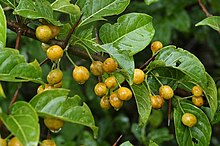| Meyna laxiflora | |
|---|---|

| |
|
Scientific classification
| |
| Kingdom: | Plantae |
| Clade: | Tracheophytes |
| Clade: | Angiosperms |
| Clade: | Eudicots |
| Clade: | Asterids |
| Order: | Gentianales |
| Family: | Rubiaceae |
| Genus: | Meyna |
| Species: | M. laxiflora
|
| Binomial name | |
| Meyna laxiflora Robyns
| |
Meyna laxiflora is a species of flowering plant in the family Rubiaceae. It has a world-wide distribution across tropical and subtropical regions. [1]
Description
Meyna laxiflora is an armed shrub or small tree with greenish-yellow flowers. The calyx of the flower is cup shaped, and the fruits of the tree are round, fleshy, and edible. [2] It flowers in January to March. [3]
References
- ^ "Plant Name Details: Meyna laxiflora Robyns". The International Plant Names Index. Retrieved 4 December 2017.
- ^ Umberto Quattrocchi (2016). CRC World Dictionary of Medicinal and Poisonous Plants: Common Names, Scientific Names, Eponyms, Synonyms, and Etymology (5 Volume Set) (reprint ed.). CRC Press. p. 2494. ISBN 9781482250640.
- ^ B. K. Gupta, ed. (2000). Higher Plants of Indian Subcontinent. Additional Indian journal of forestry. Vol. 3. Bishen Singh Mahendra Pal Singh. p. 102.
| Meyna laxiflora | |
|---|---|

| |
|
Scientific classification
| |
| Kingdom: | Plantae |
| Clade: | Tracheophytes |
| Clade: | Angiosperms |
| Clade: | Eudicots |
| Clade: | Asterids |
| Order: | Gentianales |
| Family: | Rubiaceae |
| Genus: | Meyna |
| Species: | M. laxiflora
|
| Binomial name | |
| Meyna laxiflora Robyns
| |
Meyna laxiflora is a species of flowering plant in the family Rubiaceae. It has a world-wide distribution across tropical and subtropical regions. [1]
Description
Meyna laxiflora is an armed shrub or small tree with greenish-yellow flowers. The calyx of the flower is cup shaped, and the fruits of the tree are round, fleshy, and edible. [2] It flowers in January to March. [3]
References
- ^ "Plant Name Details: Meyna laxiflora Robyns". The International Plant Names Index. Retrieved 4 December 2017.
- ^ Umberto Quattrocchi (2016). CRC World Dictionary of Medicinal and Poisonous Plants: Common Names, Scientific Names, Eponyms, Synonyms, and Etymology (5 Volume Set) (reprint ed.). CRC Press. p. 2494. ISBN 9781482250640.
- ^ B. K. Gupta, ed. (2000). Higher Plants of Indian Subcontinent. Additional Indian journal of forestry. Vol. 3. Bishen Singh Mahendra Pal Singh. p. 102.